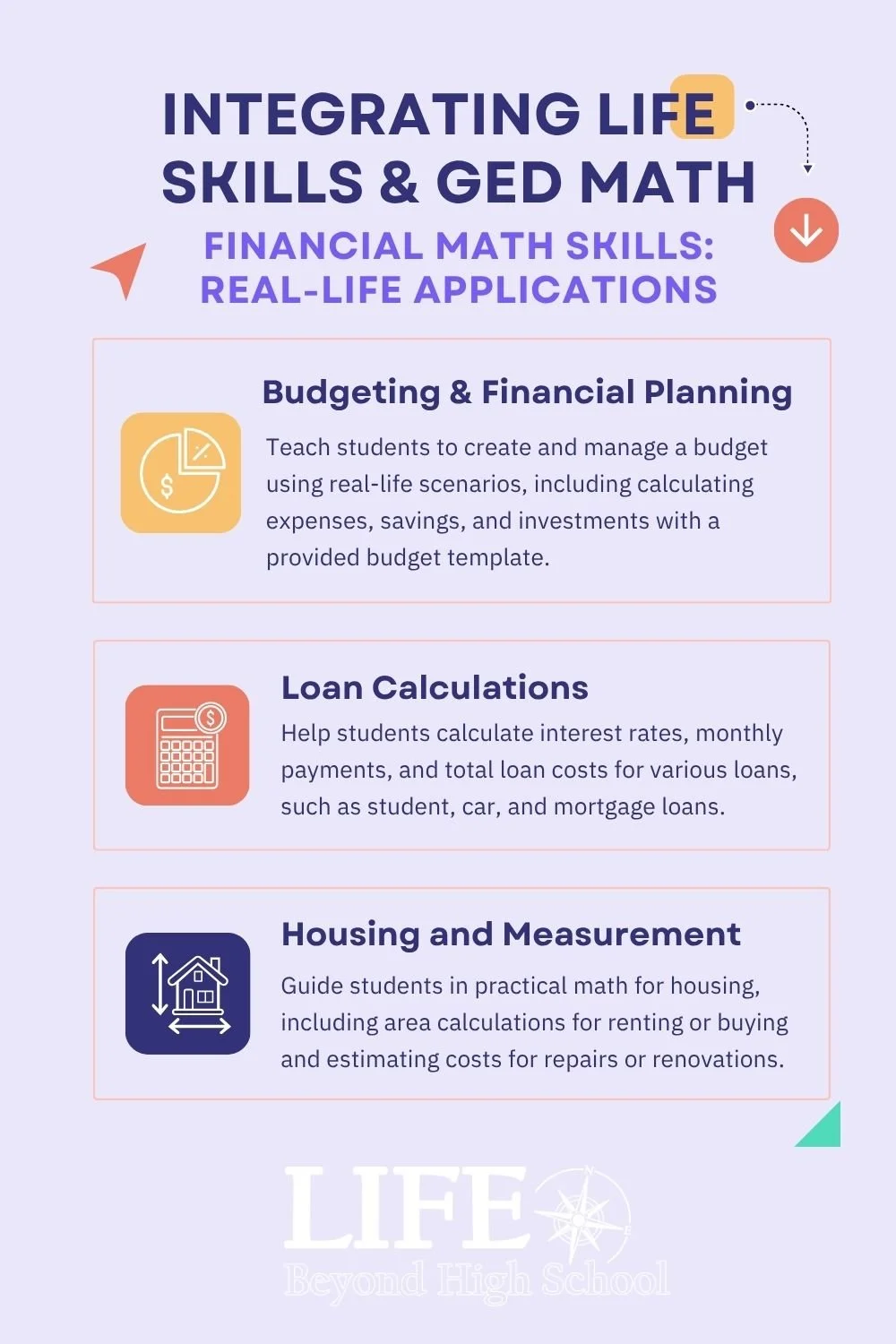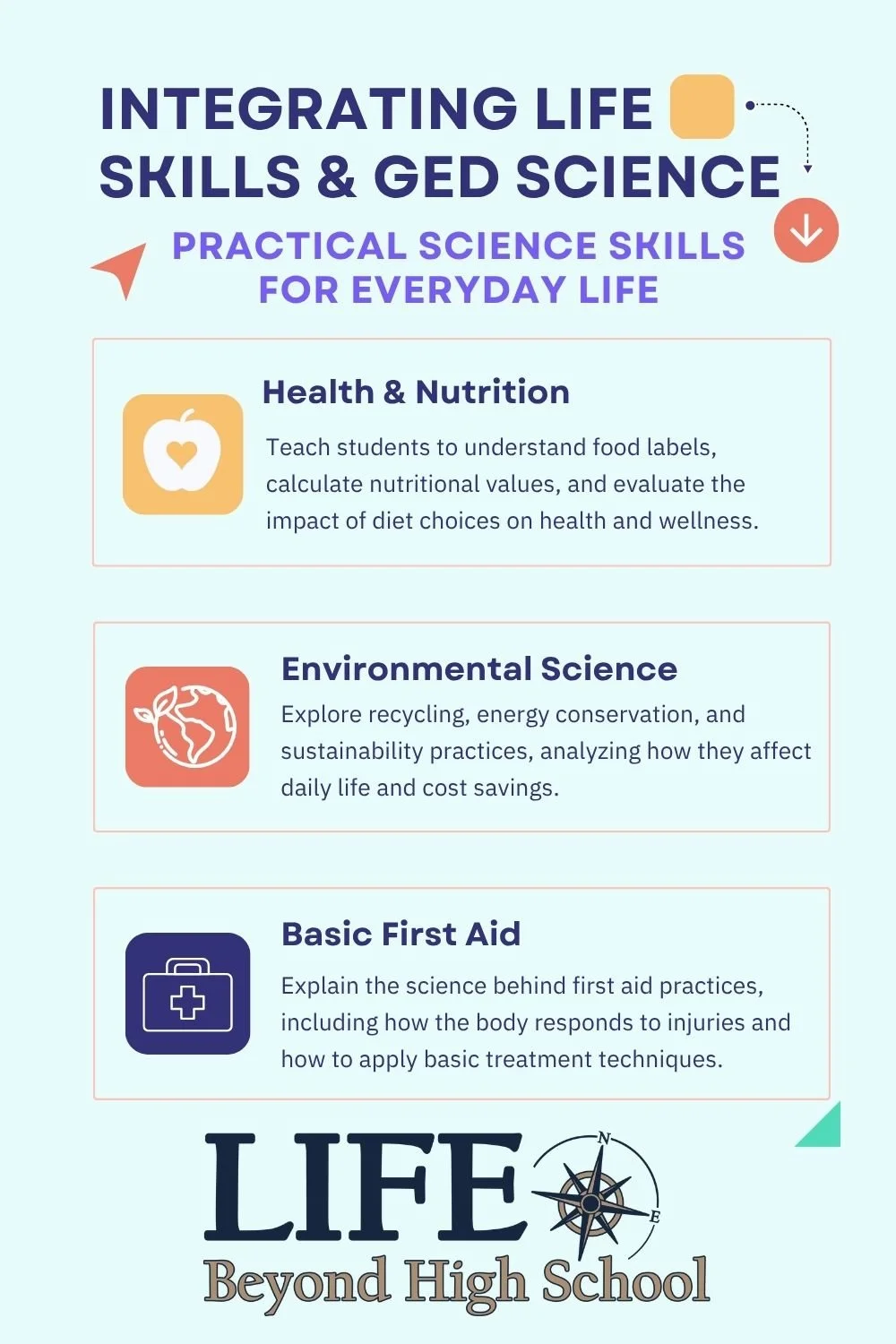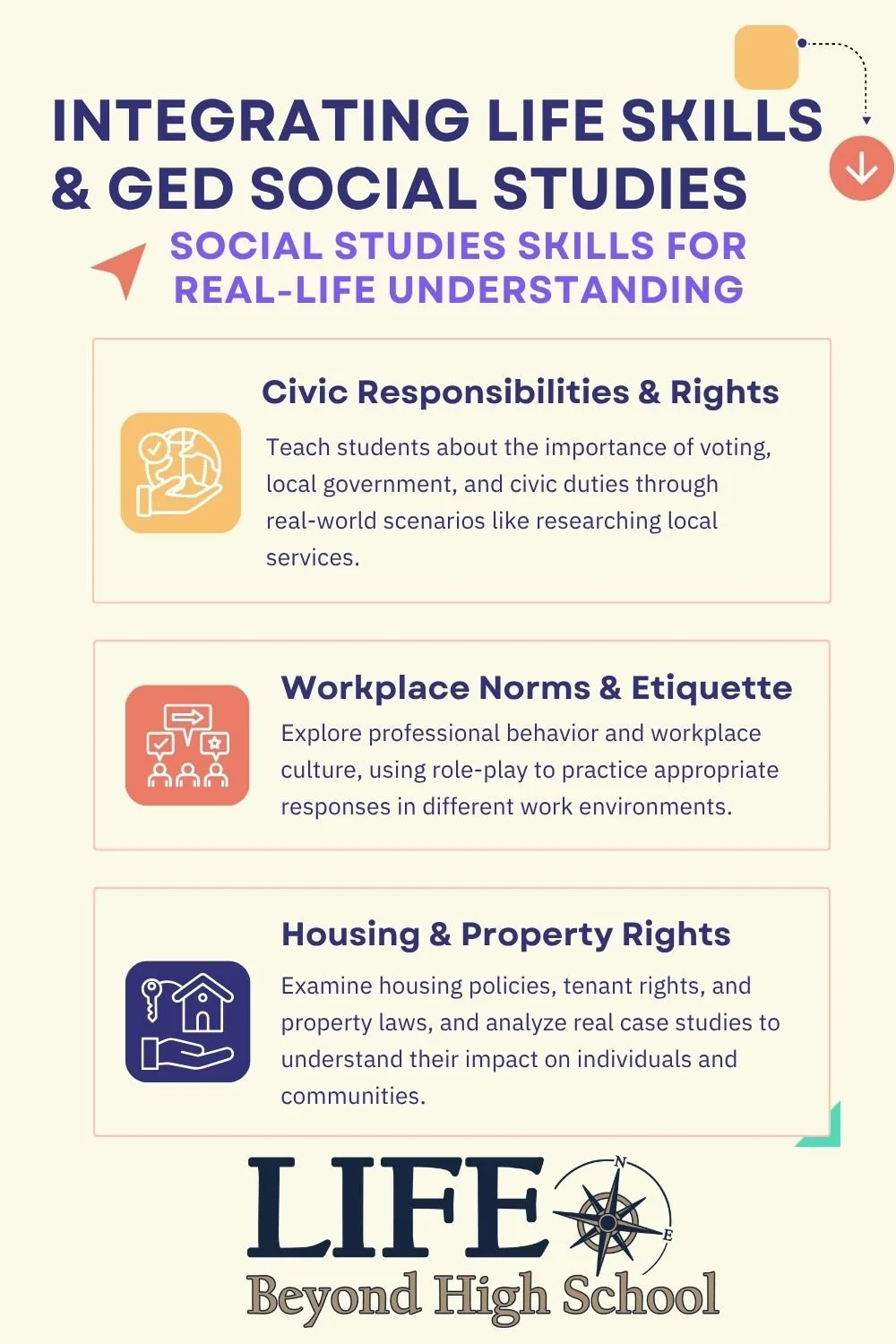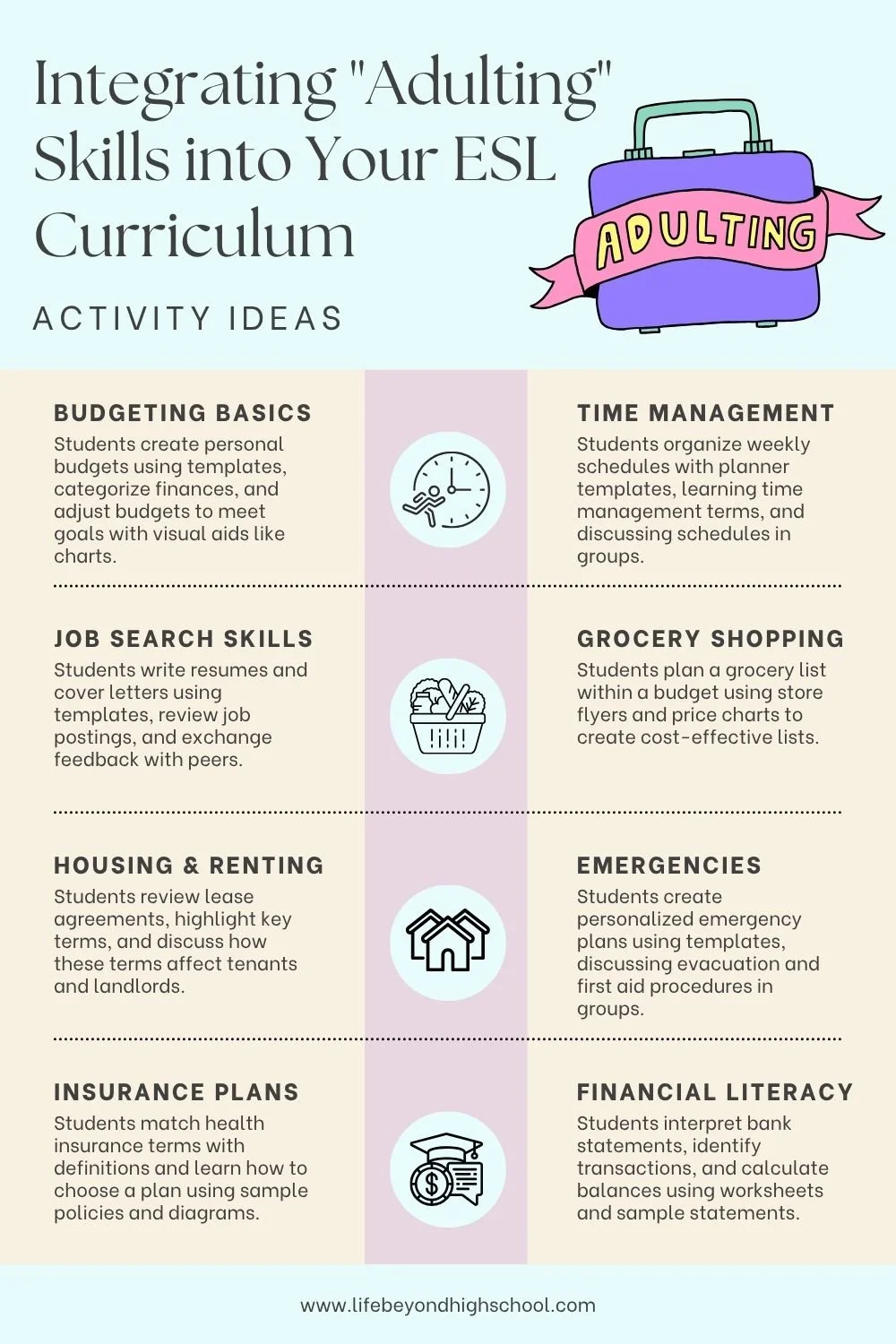Practical Guide to Teaching Life Skills in Adult Ed – Part 2
✨This is Part 2 of a 3-part series on teaching life skills in adult education. Catch up on Part 1 ← Why Teaching Life Skills Matters | Continue to Part 3 → A List of Life Skills Every Adult Should Know
How to Teach Life Skills in GED and ESL Programs
If you read Part 1, you already know that teaching life skills is more than a nice add-on. It’s the bridge that helps adult learners turn academic progress into real-life success. But knowing why it matters is just the beginning. The real challenge? Figuring out how to fit it all in.
Fortunately, teaching life skills and incorporating "adulting activities" doesn’t have to be separate from your core GED or ESL curriculum. Some of the best learning happens when you embed them directly into your existing subjects.
Let’s break it down by content area, with classroom-ready examples and practical tips for teaching life skills through adulting activities that your students will benefit from immediately.
Embedding Life Skills in GED and ESL Curriculum
Having taught both high school and adult education, I’ve found that adult ed is unique in one big way: the rubber has already met the road. These students aren’t just imagining what adult life might look like someday; they’re already in it. They’ve got jobs, bills, families, car insurance, responsibilities. That means they appreciate when what they’re learning connects to their real lives.
If students can use math to calculate their car insurance premiums or build reading comprehension skills by working through a child development passage, they stay more engaged. It gives them context. It creates relevance. It turns academic work into something that feels useful.
Whether you’re teaching math, science, social studies, or language arts, there are creative ways to embed adulting activities that support both academic and personal success.
Life Skills in Math
Math is one of the easiest places to sneak in life skills that feel instantly relevant. From budgeting to understanding loans, students can practice math in ways that make a real impact on their daily lives.
Budgeting and Financial Planning Activity
Provide students with a sample income and a budget template. Ask them to calculate expenses for housing, food, transportation, and savings. Have them compare needs vs. wants and explore how different choices impact their financial future.
If you're looking for ready-to-use resources, the Budgeting Puzzle Set is great for reinforcing vocabulary, and the Financial Independence Lesson includes a look at different types of budgeting, like envelope budgeting and zero-based budgeting.
Spoiler: Starbucks every day adds up fast.
Loan Calculations Activity
Introduce loan terms and interest rates. Use online calculators to help students determine monthly payments and the total cost over time. Discuss the implications of borrowing and compare options. This is a great moment to reinforce vocabulary and explore real-life loan language using the Borrowing Basics Puzzle Set.
Housing and Measurement Activity
Have students calculate the area of a room to estimate the cost of flooring or paint. Tie in real-world math by incorporating price-per-square-foot, overage estimates, and DIY vs. professional costs. This kind of hands-on math becomes even more meaningful when connected to real-life situations, like preparing to move into an apartment. Consider pairing this with the How to Rent an Apartment Lesson if you want to cover topics like move-in inspections, security deposits, or the potential consequences (fiscal and social) of painting the living room teal without your landlord’s permission.
Activity ideas for teaching life skills through math
Life Skills in Science
Science class might not scream "adulting," but it’s full of opportunities to connect academic content to students' health, safety, and everyday decision-making. Here are a few science-based adulting activities that build both knowledge and confidence.
Health and Nutrition Activity
Use nutrition labels to calculate calorie intake and compare food options. Lead a discussion on how nutrition impacts energy, focus, and long-term health. A great follow-up would be a simple meal planning activity using a grocery app.
Environmental Science and Sustainability Activity
Have students assess household energy usage and brainstorm ways to reduce it. Bonus: Invite students to contact local utility companies to request free energy audits or savings tips.
Basic First Aid Activity
Teach basic first aid procedures and explain the biology behind them. For example, when someone applies pressure to a bleeding wound, they’re not just trying to stop the mess, they’re helping the blood clot. You can explain how platelets in the blood respond to pressure by forming a plug, which is the first step in wound healing. When students understand the biology behind what they’re doing, they’re more likely to remember and use those skills when it matters. Consider partnering with local first responders or the American Heart Association to offer CPR or first aid certification.
If your students are inspired by the topic of safety, you can pair this activity with the Emergency Preparedness Puzzle Set for extra vocabulary and a real-world connection.
Activity ideas for teaching life skills through science
Life Skills in Social Studies
Social studies offers the perfect context for adulting activities related to civic life, employment, and housing rights.
Civic Responsibilities and Rights Activity
Assign students to research local government services and present how those services impact their community (e.g., public transit, housing, health clinics). You might have one group look into how public transportation affects job access, while another explores how housing programs support low-income families. These real-world connections help students see how local policies directly shape daily life.
Workplace Norms and Etiquette Activity
In my Starting a New Job Lesson, students read or listen to short workplace scenarios where someone makes a common faux pas, like talking too loudly on the phone or reheating fish in the communal microwave. Then they identify what went wrong and brainstorm better ways to handle the situation. It’s a low-pressure way to build communication and problem-solving skills, while reinforcing expectations they might encounter on the job.
You can extend the learning or reinforce vocabulary using the Soft Skills for Employment Puzzle Set as a warm-up or follow-up activity.
Housing and Property Rights Activity
Use real or fictional case studies to explore legal issues like tenant rights, rental agreements, and eviction laws. Follow up with a mock debate or written reflection.
If you want to give students a chance to practice reading the fine print, try this free Reading and Signing a Lease activity. They’ll analyze a sample lease and pull out key details like due dates, deposits, and maintenance responsibilities. These are skills they'll need if they're planning to rent a place of their own.
Activities for teaching life skills through social studies
Life Skills in Language Arts
Language arts gives you the perfect excuse to sneak in all kinds of real-life prep: resumes, forms, interviews, you name it.
Resume and Cover Letter Activity
Have students find a local job posting, then write a tailored resume and cover letter. Review drafts as a group and offer constructive feedback. If you're looking for something ready-to-go, the Job Searching Lesson includes direct instruction on how to read and evaluate job postings, plus a built-in activity where students practice spotting red flags for scams. It's a great way to build both critical thinking and career-readiness skills.
Reading Legal Documents Activity
Use sample lease agreements, job contracts, or medical forms. Ask students to highlight key terms, identify responsibilities, and summarize the main ideas. To bring this to life, you can use the free Reading and Signing a Lease activity. It walks students through a realistic lease and gives them hands-on practice identifying things like rent due dates, security deposits, and maintenance responsibilities; important details they'll definitely want to understand before signing on the dotted line.
Interview Skills Activity
Start with a list of common interview questions and give students time to brainstorm and rehearse their responses. Then pair them up for mock interviews where they can practice not just what they say, but how they say it, with eye contact, posture, pacing, and all. Encourage peer feedback and create space for reflection.
Students groan when I introduce this activity. But it always turns out to be one of the most engaging parts of our career readiness unit. I’ve brought in administrators, paraprofessionals, SLPs, and even fellow teachers to act as interviewers. We set up an inside-outside circle, where students rotate every two minutes and answer a different question at each station. Sometimes we flip the roles and have students do the interviewing, which is always a crowd favorite. Once they get going, they open up, start having fun, and become much more comfortable talking about themselves. It’s especially helpful when staff model their own answers, and it builds great rapport across the classroom community.
Activities for teaching life skills through language arts
Supporting English Learners with Life Skills
Many English learners arrive with plenty of adulting experience, they just need the language and cultural context to apply it in a new space. Teaching life skills to English learners means bridging gaps in terminology, expectations, and systems.
Language-Rich, Visual Activities
Use labeled diagrams, real-world documents, and bilingual word banks to support comprehension. Build vocabulary in context rather than isolation.
Culturally Responsive Scenarios
Choose scenarios that reflect students’ backgrounds and experiences. When discussing things like financial practices or housing options, ask how it compares to their home country.
Scaffolded Discussions
Give students time to think, speak in pairs, or use sentence frames before full-class sharing. Allow for multilingual discussion when possible to support concept development.
Life skills activities and ESL
Ready to Go Deeper?
In Part 3, we’ll walk through the top 10 life skills all adults should learn, complete with links to classroom-ready resources.
In the meantime, I invite you to check out these no-prep, high-impact resources:
You don’t have to teach everything at once. Start small, be intentional, and know that even one well-placed adulting activity can make a lasting impact.





